Menu
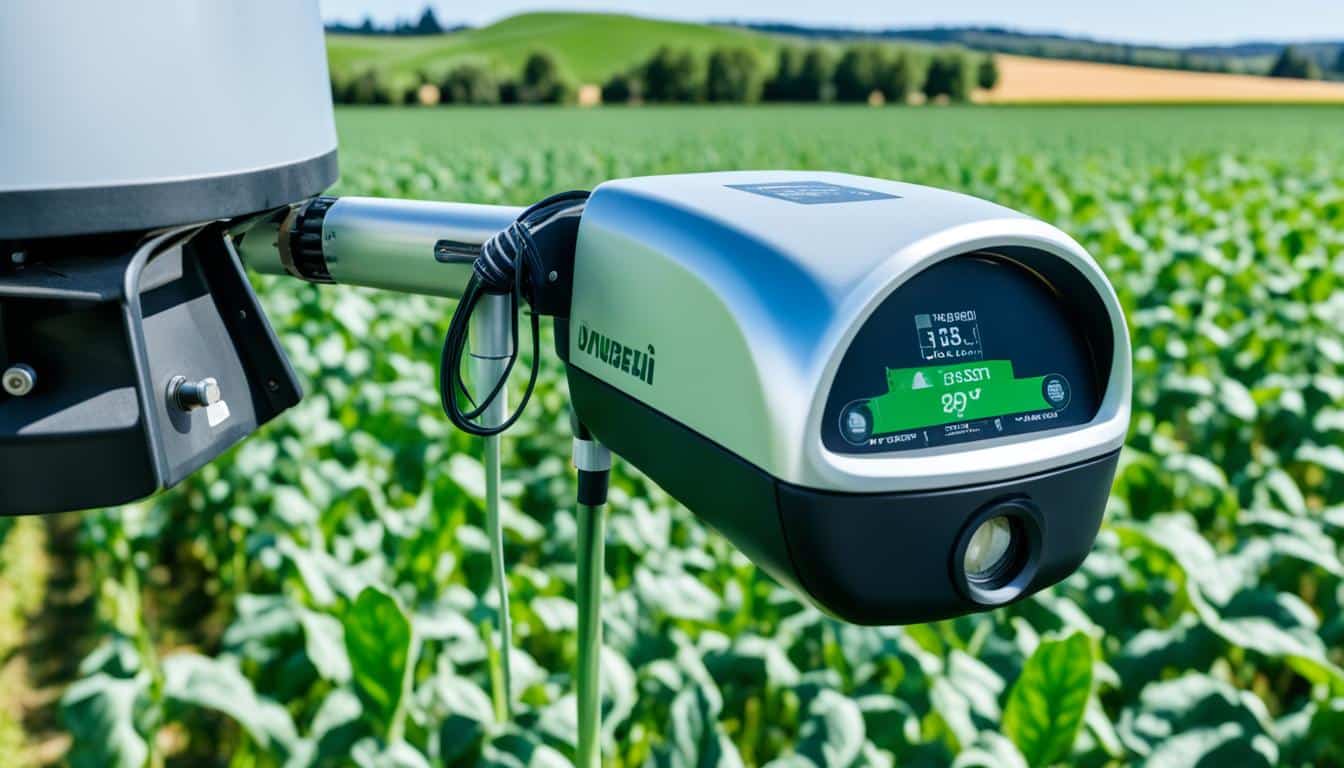
In 2023, the global market for yield monitoring systems hit a super high USD 2.9 billion. This shows how important these systems are in farming today. They use special sensors and devices to track harvests. This helps farmers use resources better. It also makes farms more green and profitable.
Yield monitoring systems do much more than just be cool tech. They help farmers use resources wisely and follow the rules properly. Getting the crop data right lowers waste. It also makes the crops better and helps the environment. Because of these systems, keeping farm records and meeting rules is simpler. This lets farmers focus more on their work.
Yield monitoring systems are key in today’s farming, changing how we look at farm yield and help crops grow better. They started being used in the early 1990s and they’ve since played a major role in using resources wisely and cutting down on waste.
Precision agriculture includes high-tech tools like yield monitors and advanced crop watching devices. These give farmers the information they need to make smart choices. This covers important parts of farming such as when to plant, watering, fighting bugs, and managing farm yield.
These systems come with many sensors. They measure things like how much grain flows and the dampness. Each sensor has to be set up properly to make sure the data is right. A special calibration process, which means testing with different loads, is used to get the sensors to measure correctly.
Also, calibrating the sensor for the speed of the vehicle is very important. To do this, farmers drive their combine over a known distance. This helps work out the exact speed. Doing this carefully means the data about the farm yield is very accurate, which is crucial for making good yield maps.
In 2015, the USDA found that about half of farmers who use yield monitors create these maps. The maps show where the land produces less or more. They help farmers know where to use more or less of things like fertiliser. Having years of these maps helps farmers make the best choices for their fields.
By using yield maps, farmers can figure out how to get better yields. They learn which parts of their field need more or less of something. This technology, combined with other farming tools, gives a clear picture of how well the farm is doing. Recent studies, like one in Crop Science 2019, show how using yield maps has changed farming for the better.
Yield monitoring systems are made up of many parts. Their goal is to give farmers detailed insights into how their crops are doing. They use precision agriculture solutions to make sure data is right, helping farms do better. Key parts include agricultural sensors, data loggers, and GPS tools. They all work together to track and understand important yield data.
Mounting agricultural sensors on harvesters is a key step in yield monitoring systems. These sensors check things like how much grain is moving and its moisture levels. Keeping accurate yield records is crucial for crop insurance and showing how well the farm is doing.
Calibrating the mass flow sensor is important. Farmers need to follow the maker’s advice when harvesting grain loads of 3,000 to 6,000 pounds. This calibration helps the sensor work accurately no matter the grain flow rate.
Data loggers store the information from the sensors. They are like the brains of the yield monitoring system. This stored data comes in handy for meeting rules and keeping farm records quickly.
It’s vital to calibrate yield monitors often. This makes sure the collected data about crops is right. Correct data helps farmers apply the right amount of resources. It also helps the environment and the farm’s profits.
Using GPS in yield monitoring is all about getting better data accurately. GPS helps check where things happen on the farm. This is key for making smart choices and managing the farm well.
There can be issues with time delays in yield mapping. To avoid errors, systems can use things like magnetic sensors or switch positions. The goal is to measure header height accurately for better data. Good crop monitoring technology with GPS lets farmers use precise data to boost their field’s performance and sustainability.
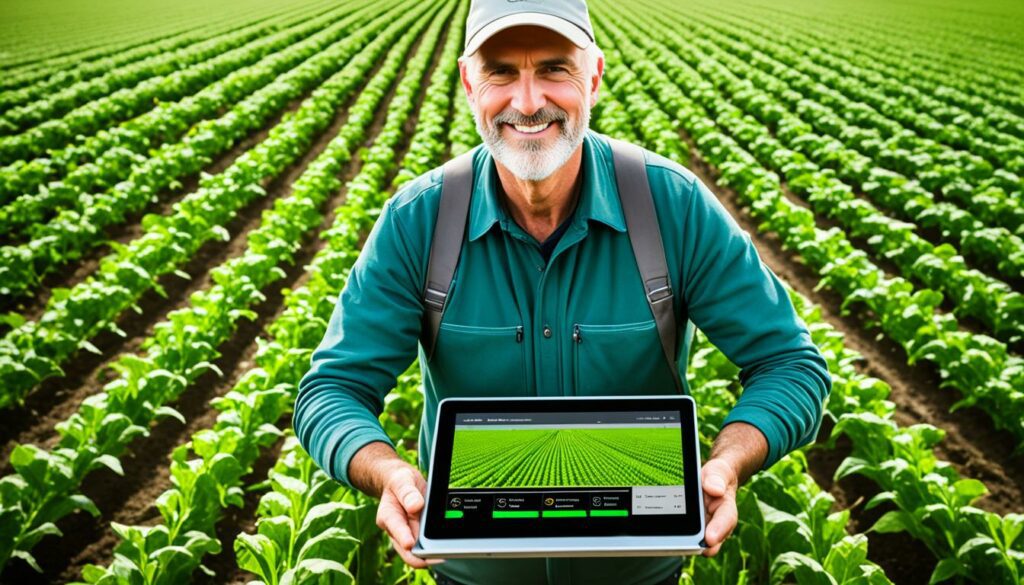
Accurate yield data is key for farmers looking to improve their farms. With real-time crop data, they can understand what affects their crops. This includes things like how much moisture the soil has and how well fertilisers work.
Good yield data helps farmers make smart choices. Tools like yield monitors show how well crops are doing in different parts of the farm. This info helps farmers use the right amount of things like fertilisers and water, cutting waste. This makes farming better for the environment and more efficient.
Having precise yield data also helps farmers focus on areas that need more care. For example, spots that are not growing well might need better drainage. Farmers can use this data to spend their resources wisely, improving overall crop growth. It also helps figure out the best amount of nitrogen and water for crops like corn.
Keeping sensors and monitors working well is vital. Regular checks and careful calibration keep the data reliable. This aids farmers in making solid money decisions. Using top brands like Deere®, Precision Planting®, and Ag Leader® makes this job easier, saving time and improving data quality.
Yield data is especially important for corn and soybeans. It shows where crops aren’t doing well in the fields. Early spotting of problems, like soybean cyst nematodes, can save a harvest. For farmers wanting the best from their land, this technology is crucial.
Getting accurate yield data relies a lot on yield monitoring equipment. Proper calibration makes sure agricultural sensors give correct info to farmers.
It’s smart to calibrate when crop conditions shift, like with corn above 20% moisture. Doing this every 2.5% moisture change keeps errors under 5%. If we don’t recalibrate, the data for the field’s total yield and its map could be wrong.
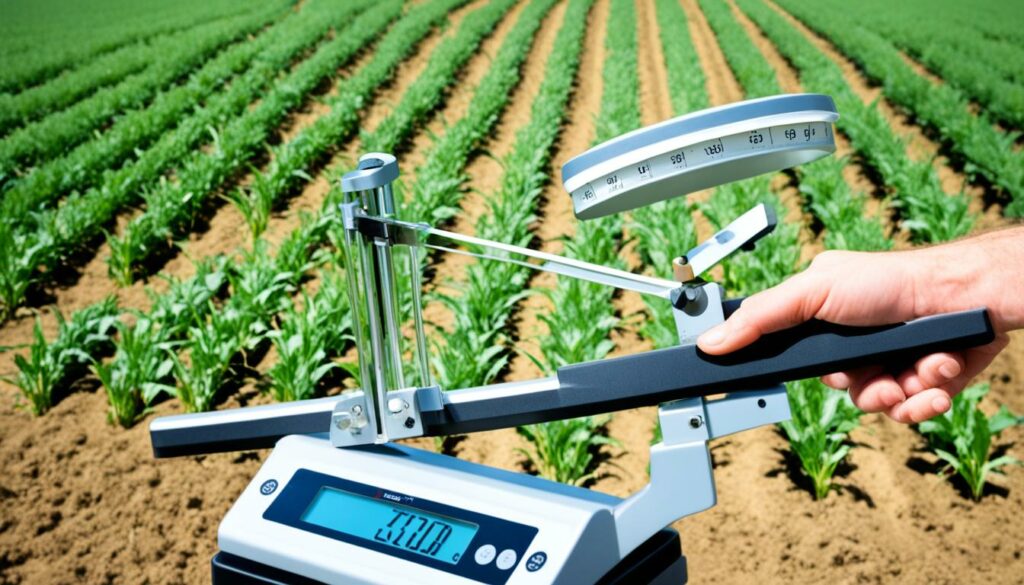
Some yield monitors can calibrate themselves a bit, needing less from the farmer. But most need a careful touch. You have to check the accuracy of the scale often, using real weights to compare.
Make sure the sensors are clean to keep the monitors accurate. Calibrate them separately for each crop. The machines might take 10 to 15 seconds to react, affecting the data if not calibrated well.
You might need to recalibrate during harvesting if the environment or the crop changes a lot. Especially for big shifts in moisture level or after repairs. Monitors don’t just measure how fast the grain moves but this movement itself changes based on many factors.
Carefully calibrated monitors give exact yield by acre numbers. The size of the cut by the machine header matters very much. Check every day during the season to ensure everything is set correctly before harvest.
| Calibration Technique | Requirements |
|---|---|
| Multi-Point Calibration | Three to six loads (3,000 to 6,000 lbs) |
| Single-Point Calibration | Larger loads (up to a full grain tank) |
Calibration errors are kept low, usually 0.5%, when testing many grain flows. But errors can soar to 100% if not calibrated. A lot of things affect calibration accuracy, like the season, field shape, and different corn types.
So, do regular checks and recalibrations to keep data true. When starting the season, make sure all sensors are well calibrated. Good data from these monitors helps farmers compare fields and make smart management choices.
Calibrating mass flow sensors is key to getting precise measurements in yield monitoring gear. A good calibration method boosts the accuracy of yield info. This is vital for sound decisions in precision farming. Now, let’s dig into how these calibrations work.
To calibrate, we often take an average of three loads. Each load is between 3,000 to 6,000 pounds (or 50 to 100 bushels). The aim is to set a reference point that guarantees accurate readings. The load should match what we see in real harvests.
The multi-point method is detailed. It checks the sensor’s curve using different loads at various speeds. This includes 3 to 6 loads across different flow rates. From this detailed process, we get a reliable calibration curve. It ensures the equipment reads right in all situations.
USDA Economic Research Service (2015) points out that yield maps can have errors due to mass flow time delay. Over 50% of yield monitor users face this issue.
In both single and multi-point calibrations, checking the weight of the loads is vital. This is done using tools like seed buggies or truck scale tickets. Also, keep the sensor clean and make sure other parts like the grain elevator are working well. This helps the yield monitor stay accurate.
| Calibration Method | Number of Loads | Load Weight (lbs) | Grain Flow Rates |
|---|---|---|---|
| Single-Point | 3 | 3,000 – 6,000 | Average |
| Multi-Point | 3 – 6 | 3,000 – 6,000 | Variable |
Following these calibration steps greatly improves how yield monitoring gear works. This, in turn, helps precision farming techniques succeed.
Getting moisture sensors right is key in farming tech today. To do crop monitoring accurately, these sensors must be spot on. This means keeping them calibrated and checked often. This is crucial for farms to run smoothly.
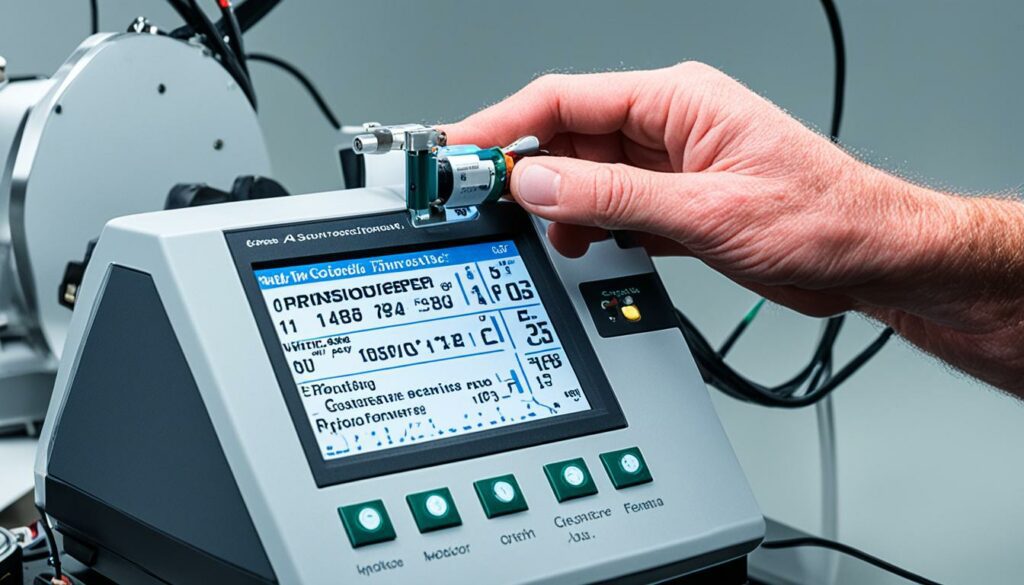
Moisture sensors get calibrated with very precise tools. This ensures they measure dry output correctly. It’s important to adjust for different crops and how machines are set up.
| Calibration Step | Description |
|---|---|
| Initial Calibration | Use top-notch tools to set an initial standard. |
| Annual Checks | Check the sensors closely once a year to keep them working well. |
| Periodic Adjustments | Change settings when needed, like when you switch crops or machines. |
After the first calibrations, sensors must be looked at often. These checks make sure they’re working right. They also include fixing settings for machine height and making sure the GPS is accurately set.
Farmers who are thorough with calibrating and inspecting benefit a lot. It helps them make better choices and manage their farms efficiently.
Ground speed sensors are key for getting precise yield data. This data is crucial for managing farm yield well. It’s vital to regularly check and calibrate these sensors. Doing so makes the data more trustworthy.
Calibrating ground speed sensors is not too hard. First, mark a known distance in your field. Then, time how long it takes to travel that distance. Compare the sensor’s speed reading to the one you calculated. This helps check if the sensor is accurate.
Using the correct calculations is key in ground speed sensor calibration. Multiply the sensor’s speed by the swath width to find the area harvested. This step is crucial in yield monitoring. Here’s what to do:
Calibrating ground speed sensors well is the foundation of getting good yield data. This supports better farm yield management. And it leads to making farming decisions that are both sustainable and profitable.
Yield monitoring systems have changed farming by blending old wisdom with new tech. Since the 1990s, they have become essential for making farms work better and smarter. They help farmers not only do their work more efficiently but also make better decisions.
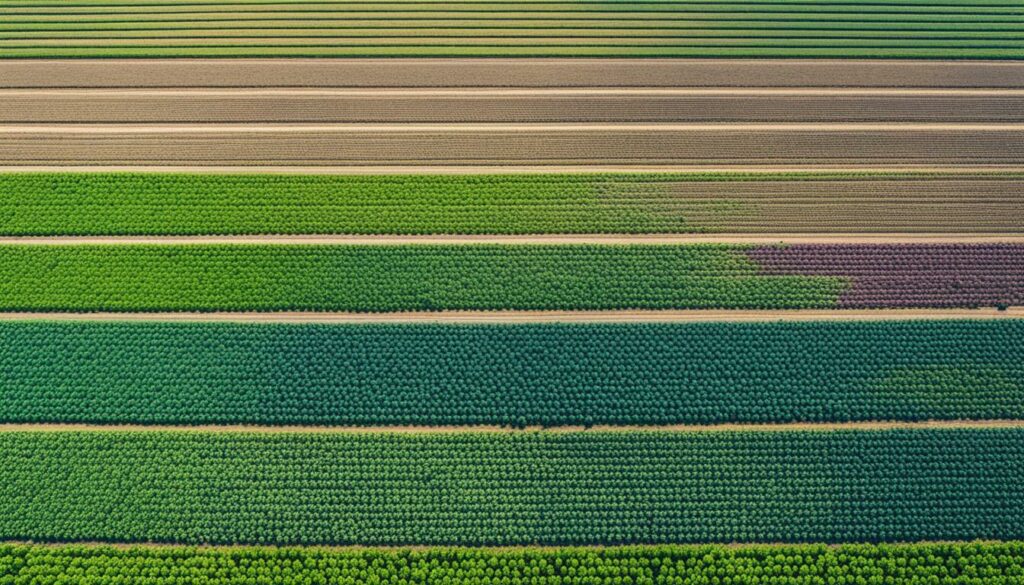
One key benefit is spotting differences within fields. Farmers can see exactly where crops do well or not so well. This insight, displayed in detailed maps, lets them adjust farming practices. They can choose when and where to till the soil, fertilise, or water their crops. This makes farming more efficient and effective.
Variable Rate Fertilisation (VRF) is a great example. Thanks to these maps, farmers can apply fertiliser only where it’s needed. This saves resources and reduces harm to the environment. Adding moisture data to the mix helps in planning water use wisely.
Yield maps are also valuable for financial reasons and ensuring sustainability. They help farmers get loans by showing their farm’s potential. Plus, farmers can use them to test new products. This contributes to the advancement of agricultural science.
Thanks to GPS and sensors, these systems collect detailed farming data. This information is crucial for making smart farm management choices. These systems have proven their worth over the last 30 years. They are key for the future of sustainable farming.
Below is a table summarising the advantages of yield monitoring systems:
| Advantage | Description |
|---|---|
| Operational Efficiency | Streamlines farming operations with precise data. |
| Enhanced Decision-Making | Utilises yield data for informed agronomic decisions. |
| Optimised Resource Use | Improves fertilisation, irrigation, and soil management. |
| Financial Viability | Provides data for securing loans and financial planning. |
| Scientific Research | Assists in testing new agricultural products and methods. |
In the end, yield monitoring systems greatly improve farming. They help with everything from making decisions to planning the use of resources. Plus, they move us towards more sustainable farming practices.
In the world of modern farming, getting real-time crop data is super helpful. It lets farmers act quickly when their crops need attention. This is key in making agriculture more precise.
Since the early 1990s, yield monitoring tools have gotten much better. Now, they are vital in farming. Take Ag Leader’s technology, for instance. It started in 1992 and has improved a lot since. It’s now a must-have in many harvesters.
For precise farming, sensors are very important. They check on various things like the grain flow and how fast the outdoor elevator moves. They also use GPS to track the locations and other sensors for important details. All this info is used to create maps that show how well crops are growing in different parts of the field.
One key step in making good maps is taking out any false points. This means removing any misleading data. By doing this, the results are more accurate. They help farmers plan better.
These maps are really useful. They help farmers see where their crops are doing well or not so well. Then, farmers can set goals for different areas based on these maps. Having maps from at least five years back is best. It takes into account weather changes and other things that can affect the crops. This way, the info is trustworthy for making future plans.
| Sensor Type | Function |
|---|---|
| Grain Flow Sensor | Measures the rate of grain flow into the combine |
| Moisture Sensor | Monitors the moisture content of harvested grain |
| GPS | Provides location data for spatial mapping |
| Header Position Sensor | Tracks the position of the combine’s header |
| Travel Speed Sensor | Records the speed of the harvester |
Collecting real-time data helps farmers make smart choices. They can adjust when to fertilise, water, or control pests. This clever way of farming can boost how much crop is produced and how profitable the farm is.
The AgFiniti app from Ag Leader is a great example of how tech and farming come together. It links data from the fields with mobile devices. This makes sharing progress and data super easy. It’s a big step towards smarter farming that fits with precision agriculture methods.
Using real-time crop data in precision farming makes everything better. It helps farming be more effective and sustainable. By using past data, the latest sensors, and accurate maps, farmers can know what to do. This pushes farming towards being more efficient and productive.
Precision agriculture solutions are key in today’s farming. They let farmers manage fields with high precision. This is done through the latest technology. It includes tools for monitoring crops and managing yields. Thanks to these, farmers can grow more sustainably and efficiently.
Field productivity zoning sorts farms into different areas. Each area has its own productivity level and needs. It uses real-time data from yield monitoring. This data helps farmers apply fertilisers, water, and pest control exactly where it’s needed. By doing this, farmers can get better yields across the farm.
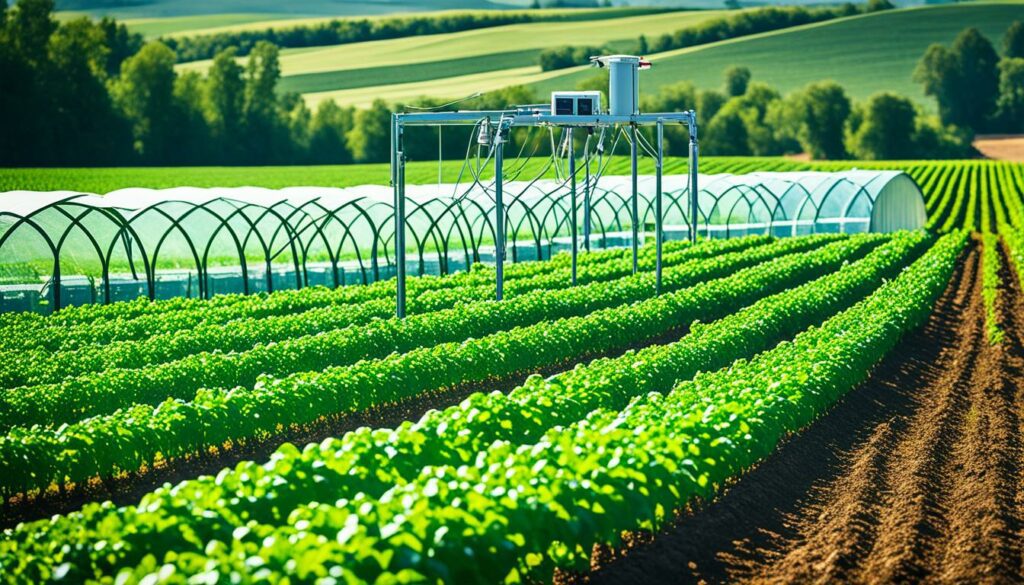
Precision irrigation focuses on using water smarter. Crop monitoring tech figures out the right water amounts for each field area. This reduces water waste and improves crop health. It watchs soil moisture, weather, and plant growth to water at the perfect times.
“Yield monitoring technology allows farmers to assess when to harvest, fertilise, seed, and understand the effects of weather, ensuring timely and informed decisions.”
Precision agriculture gives farmers the power of data. It helps them make choices that grow more, while taking care of the planet. Mixing yield management with crop monitoring could change farming for the better.
Yield mapping tech changes how we manage farm yields. It lets us deeply understand and plan better. By making and reading yield maps, we learn a lot about where crops grow best.
Yield maps are made by combining many precision farming tools. This might include a grain flow sensor and a GPS antenna. Such systems were first seen in the 1990s, starting with Ag Leader’s yield monitor in 1992.
They work together to show how crop yields change across a field. This helps farmers see the big picture on crop performance.
The system sometimes has a delay in showing the grain flow, about 10 to 12 seconds. To get accurate readings, start and end delays need to be sorted out. This is done through careful data handling to correct for such delays.
Understanding yield maps is crucial for better farm yields. Farmers use ‘normalised yield’ to compare real yields to the field’s average. This comparison helps spot issues and set goals.
A good data set is at least five years of yield maps. Having this much info lets farmers dig deep into what affects their yields. They can also plan better where and how much to use farm inputs.
Ag Leader’s tools make this easier. Their system allows quick calibrating for better accuracy. Plus, farmers can keep an eye on their fields with live activity tracking through AgFiniti, no matter where they are. This means smarter choices.
Thanks to these technologies, farmers can make their crops do better. This leads to more yield and profit on the farm.
Over the last few years, artificial intelligence (AI) has made a big splash in farming. It’s changed the game for tracking crop yields. AI tools help farmers make smarter choices by using data to predict outcomes and give instant updates.

AI’s predictive power is key in monitoring crop yields. It looks at past data and weather to guess future yields. This lets farmers change their plans early to get better results. For instance, they can use past data to guess how much energy they’ll need in the future.
This way, they can use resources more wisely, which means less waste and more productivity.
Thanks to AI, farmers can know their crops’ status right away. This is done with gadgets and sensors that send data all the time. With AI, these gadgets can also change operations based on what crops need. For example, they can adjust greenhouse light or control the climate for better growth.
Less energy is used thanks to AI, by about 15% in farming. AI lets farmers use energy smarter in tasks like irrigation. Companies like Edgecom Energy are showing how AI and the internet of things (IoT) can save both money and the planet.
| Key Benefits of AI in Yield Monitoring | Impact |
|---|---|
| Predictive Analytics | Improved yield estimation and resource allocation |
| Real-Time Monitoring | Enhanced decision-making and dynamic crop management |
| Energy Efficiency | Reduction of energy consumption by up to 15% |
| Environmental Benefits | Reduced emissions and optimised resource usage |
AI is leading farming into a new age, where facts and figures guide choices. By using AI’s predictive and real-time updates, farmers can do more with less. They can aim for both better yields and greener farming.
To get the best from yield monitoring equipment, follow key practices. This means doing regular calibrations, sticking to technical guidelines, and analysing data thoroughly.
It’s key to know how to calibrate well. Some systems need calibrating at many points, at speeds of 2 to 5 mph. Each load should weigh between 3,000 and 8,000 pounds. Single-point calibrations, on the other hand, use fewer loads but heavier weights, up to 25,000 pounds each.
Getting accurate yield data depends on ground speed and the distance the equipment covers. When manually calibrating for distance, make sure the ground speed stays right. Also, keep the combine’s speed steady and avoid sudden turns to keep data clear.
Moisture sensors are also critical. They give reliable moisture readings between 10% and 33%. But they need checking now and then if moisture levels change a lot. Each manufacturer might have a different way to calibrate them, but it’s good to recalibrate after big weather changes or at the start of each harvest.
To get the right yield numbers, the equipment’s parts that affect threshing and cleaning must work well. Make a point of checking the yield monitor daily and doing any needed adjustments. Cleaning the sensors and checking their calibration now and then will keep readings accurate.
Your yield monitoring gear collects lots of data, with about 200 measurements for each acre. This info lets farmers study their field closely and make smart choices. Software, like Granular Insights, helps understand how the land and management decisions affect yield, making farming more efficient.
| Calibration Method | Load Weight | Speed Range (mph) | Recommended Uses |
|---|---|---|---|
| Multi-Point Calibration | 3,000-8,000 lbs | 2-5 | High variability fields |
| Single-Point Calibration | Up to 25,000 lbs | Consistent speed | Fields with uniform conditions |
The heart of using yield monitors well is regular calibration, keeping the gear in good shape, and deep data analysis. These steps, alongside the latest tools for better accuracy, really help farmers. They serve to improve farm management and get precise yield results.
Setting up yield monitoring systems faces many *agricultural technology challenges*. These issues can stop many farmers from using this tech broadly. They include high costs and problems getting and sharing data. This can really affect how farms work, especially smaller ones.
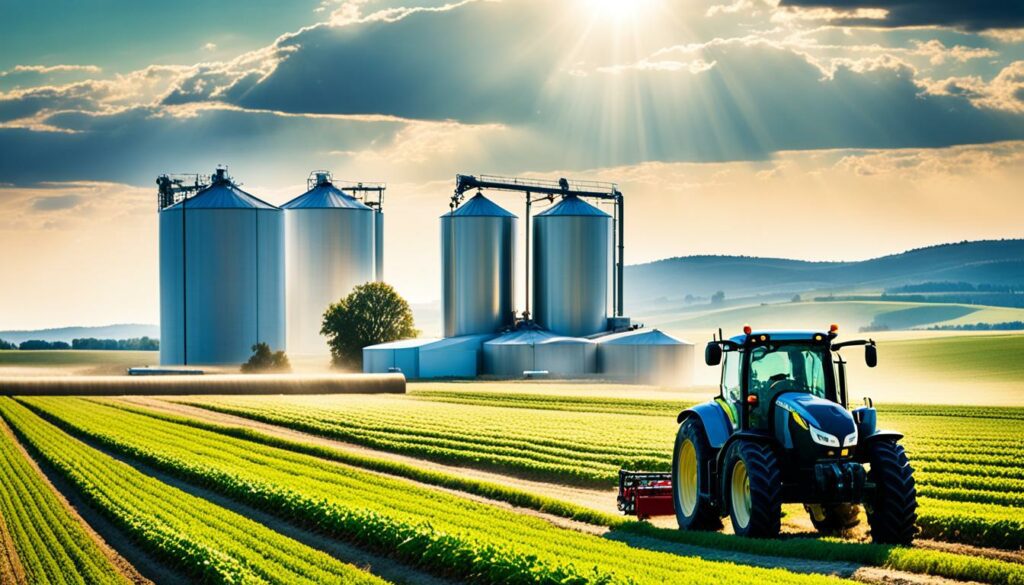
The cost is a big problem when it comes to *yield monitoring systems implementation*. By 2023, only 27 percent of U.S. farms were using advanced farming practices. This was because the tech needed is quite expensive. Although this technology can save on things like fertilisers and water, the price is still a big hurdle.
Getting hands on advanced *precision agriculture solutions* is also a struggle. Many small-scale farmers find them too costly and hard to set up. Then, there’s the issue of not being able to easily share or use the data. Plus, the equipment often can’t work with each other. All these things show we need better policies. Policies that help farmers get the tech they need and make data handling easier.
One big way to tackle these challenges is to get better at managing and sharing data. This could make using *yield monitoring systems* easier and more helpful for all types of farms.
The agricultural sector is changing fast. Today, yield monitoring advancements are more important than ever. By 2032, the market could be worth USD 5.5 billion. This growth shows how new tech and old farming methods are working together.
Artificial intelligence (AI) is a game changer in farming. It makes yield monitors more accurate and saves time. With AI, farmers can predict how their crops will do. This helps them avoid problems and run their farms better.
Getting sensors right is key. Brian Sorbe says sensor types and how often they check the crops matter a lot. By keeping sensors well-calibrated and maintained, they can be super accurate. One example is Ag Leader’s monitor, which can be as precise as 2% with proper setup.
Every farmer loves wireless data transfer these days. Steve Cubbage points out that this tech lets farmers use their data right away. This speeds up how they can figure out better ways to grow crops. Companies like Farmobile and 640 Labs are making data sharing easy and fast.
Now, let’s look at who’s shaping this field:
| Company | Focus |
|---|---|
| Ag Leader Technology | Enhancing crop yield and resource utilisation |
| Deere & Company | Sustainable farming practices |
| Precision Planting Inc | Precision farming technology |
| Raven Industries Inc | Smart farming solutions |
New farming tech is booming in emerging markets. It’s happening through smart teamwork and a focus on saving resources. Farmers are finding these tools very useful. As these tech trends continue, farming is set to be more efficient and eco-friendly.
Yield monitoring systems started changing farming in the early 1990s. They brought in precision agriculture, offering farmers ways to boost their crop performance and make more money. Farmers use a variety of sensors like grain flow and GPS. These sensors help gather important data during harvest.
This data is crucial but needs careful handling to be useful. There are complex steps to ensure accuracy, such as filtering out wrong information. Also, it’s important to compare the year’s yield against previous years. This helps farmers understand how well they’re doing and where they can improve.
Yield mapping has become key for agriculture since the 1980s. It keeps getting better, with new tools like machine vision on the horizon. Machine vision can look at plant-level details, aiding in very specific field management.
Looking ahead, yield monitoring is set to grow even more. Advanced technologies will play a key role. These systems are critical for farming that’s efficient, environmentally friendly, and profitable. They ensure farming stays competitive and sustainable.
Yield monitoring systems use high-tech sensors and equipment to measure crop parameters like grain flow and moisture in real time. They help farms to perform better, use resources wisely, and cut down on waste. Legal rules are also easier to follow with these systems.
These systems have sensors on harvesters, data loggers, and use GPS for accurate mapping. Each part is vital for getting the right information.
Accurate yield data is key for smart decisions and using resources well. It helps farmers manage their fields better, which leads to sustainable and profitable farming.
For the best results, yield monitoring tools must be calibrated properly. Mass flow sensors use different methods for checking grain flow. Moisture sensors need testing with either portable or lab tools. And, ground speed sensors must always be accurate when calculating speed.
Calibrating mass flow sensors is vital. It makes sure the systems give the right grain flow numbers. This way, farmers can make the best decisions for their crops.
Moisture sensors help by telling farmers how wet their crops are. Regular checks and good calibration mean these sensors work well. They give farmers precise information they need.
Ground speed sensors constantly need to be checked for accuracy. The process includes setting up a known distance, checking the speed, and adjusting the sensors. Getting the speed right is crucial for the yield data to be reliable.
These systems make farming easier and more effective. They help in making better decisions, use farm data well, and improve crop outcomes. With up-to-the-minute data, farmers can manage their crops flexibly and aim for better yields.
Getting crop data in real time means farmers can act right away. This means they can deal with problems quickly and improve their crops’ performance.
Precision farming includes smart fields and targeted watering. It makes farming more effective and reduces waste. By focusing on specific areas, farms use less but grow better crops.
Yield maps show where the crops do best and worst in a field. Farmers use this to plan next year’s planting and farming strategies.
AI makes yield monitoring smarter by predicting yields and monitoring crops in real time. With AI insights, farmers can make very precise decisions, improving the way they run their farms.
To make the most of yield monitors, regular calibration and following guidelines are a must. It’s also important to look closely at the data. These steps make sure the information you get is good for making decisions.
The cost and accessibility of the technology can be tough for some farmers. Solving this needs investment, education, and help for farmers. This way, everyone can get the benefits of yield monitoring.
Soon, we’ll see more AI, better sensors, and advanced data analysis in yield monitors. These changes will make farm management and farming more sustainable.